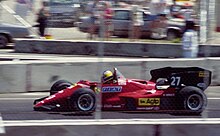Ferrari 126C
| Category | Formula One | ||||||||
|---|---|---|---|---|---|---|---|---|---|
| Constructor | Scuderia Ferrari | ||||||||
| Designer(s) | Mauro Forghieri Harvey Postlethwaite | ||||||||
| Technical specifications | |||||||||
| Chassis | carbon-fibre and aluminium honeycomb composite monocoque structure | ||||||||
| Suspension (front) | Double wishbone, inboard spring/damper. | ||||||||
| Suspension (rear) | Double wishbone suspension | ||||||||
| Engine | Ferrari Tipo021,031 1500cc 120-degree V6, turbo, mid-engine, longitudinally mounted | ||||||||
| Transmission | 6-speed sequential transverse gearbox manual | ||||||||
| Fuel | Agip | ||||||||
| Tyres | Goodyear | ||||||||
| Competition history | |||||||||
| Notable entrants | Scuderia Ferrari | ||||||||
| Notable drivers | 27. Gilles Villeneuve, Patrick Tambay, Michele Alboreto 28. Didier Pironi, Mario Andretti, Rene Arnoux | ||||||||
| Debut | 1981 Argentine Grand Prix | ||||||||
| |||||||||
| Constructors' Championships | 2 (1982,1983) | ||||||||
| Drivers' Championships | 0 | ||||||||

The Ferrari 126C was the car with which Ferrari raced in the 1982 Formula One season. It was the team's first attempt at a turbo engined Formula 1 car. It was designed by Mauro Forghieri and Harvey Postlethwaite and used between the 1981 and 1984 seasons.

Development and race history
The Ferrari 126C was designed to replace the highly successful but obsolete 312T series in use since 1975. The basic chassis was almost identical to the previous car but the smaller V6 turbo engine suited the ground effect aerodynamics now needed to be competitive, and was a better package overall. During engine development Ferrari experimented with a Comprex pressure wave supercharger[1], however due to packaging issue the engine was finally fitted with twin KKK turbochargers and produced around 600bhp in qualifying trim, detuned to 550bhp for the races proper. The car proved to be very fast but Gilles Villeneuve found the handling to be atrocious. The engine had massive turbo lag, followed by a ferocious power curve; this upset the balance of the chassis. Coupled to the chassis' hard suspension, the car tended to slide into corners before the ground effect pulled the car back on to the track. This had the undesired effects of exposing the drivers to even larger g-forces than the Williams FW07 or Brabham BT49 and making the car tend to overuse its tyres. In all it made for a very tricky driving experience.
The car was first tested during the Italian Grand Prix in 1980. In testing it proved far faster than the 312T5 chassis the team were then using and Gilles Villeneuve preferred it, though he had reservations about the handling. Early unreliability of the turbo engine put paid to Villeneuve's 1981 championship hopes but he did score back to back victories in Monaco and Spain, as well as several podium places. Because of the problematic handling the 126CK was at its best on fast tracks such as Hockenheim, Silverstone, Monza and the Österreichring.
With the arrival of Harvey Poslethwaite and a complete overhaul of the car in time for the 1982 season, things looked better. The turbo engine was further developed and reliability found, while the chassis was completely redesigned, featuring Ferrari's first genuine full monocoque chassis. Smaller and nimbler, the 126C2 handled far better than its predecessor. Villeneuve and Didier Pironi posted record times in testing with the new car and began the season promisingly with several solid results. Then came the infamous race at San Marino where Pironi disobeyed team orders and stole the win from Villeneuve. The fallout from the race led to Villeneuve's tragic death in an horrific accident during qualifying at the next round in Belgium, which left Pironi as team leader. Pironi himself was nearly killed in a similar accident in Germany, putting an end to his motor racing career, but this didn't stop Ferrari from winning the constructors' championship that year. The 126C2 was further developed during the season, with new wings and bodywork tried, and the engine's power boosted to 650bhp in qualifying trim and around 600bhp in races.
Mandatory flat bottoms for the cars were introduced for 1983, reducing ground effect, and the 126C3 was designed with this in mind. Poslethwaite designed an over-sized but effective rear wing which clawed back around 50% of the lost downforce, whilst further compensation came from the engineers who boosted the power of the engine even further, to around 700bhp. Patrick Tambay and René Arnoux scored four wins between them and were both in contention for the world championship throughout 1983 but late unreliability cost them both. However, Ferrari took the constructors' title for the second year in a row.
The 1984 season season wasn't as successful, as McLaren introduced their extremely successful MP4/2 car, which was far more effective than the 126C4 and dominated the year. Michele Alboreto won just once and Ferrari finished as runner up in the constructors' championship.
The 126C series cars won 10 races, took 10 pole positions and scored 260.5 points.
References
- ^ Ferrari, Hans Tanner & Doug Nye, 1985
